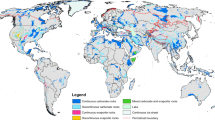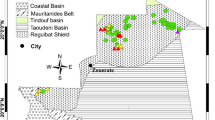Abstract
This paper proposes a new protocol to identify metallogenic provinces: about 30 elements along with the rare earths (Ce, Dy, Eu, La, Nd, Sm, Tb and Yb), Th and U in ores of the North-Latium have been investigated by INAA. Statistical procedures (enrichment factor, source discrimination and principal component analysis) had been employed to evaluate the enrichment in specific elements to investigate the possibility of an economic exploitation of some of them. Finally, the chondritic ratio of the rare earths compared to the MORB meteorite has been evaluated for determining the magma differentiation process and its effect.








Similar content being viewed by others
References
Simov SD (1988) Formation of uranium deposits. In: Recognition of uranium provinces. IAEA, Vienna, pp 17–29. ISBN 92-0-141088-3
Hunter J, Michie UM (1988) Uranium provinces and the exploration industry. In: Recognition of uranium provinces. IAEA, Vienna, pp 405–427. ISBN 92-0-141088-3; Panel proceedings series IAEA, STI/PUB/736, Bogotá, 19–23 September 1988, pp. 405–423
Locardi E, Molin D (1975) Ricerche per Uranio nel Lazio Settentrionale. CNEN Serie Rapporti, Roma
Lee B, Zhu LM, Zhang GW, Guo B, Gong HJ, Yao AP (2010) Geological characteristics, metallogenic background, and genesis of the Tongyu VHMS copper deposit in the west part of the North Qinling, Shaanxi Province. Sci China Earth Sci 53:1460–1485
Locardi E (1988) Panel proceedings series. IAEA, STI/PUB/736, Vienna, pp 35–44
Avino P, Capannesi G, Rosada A (2006) Characterization and distribution of mineral content in fine and coarse airborne particle fractions by neutron activation analysis. Toxicol Environ Chem 88:633–647
Avino P, Capannesi G, Rosada A (2008) Heavy metal determination in atmospheric particulate matter by Instrumental Neutron Activation Analysis. Microchem J 88:97–106
Capannesi G, Rosada A, Avino P (2009) Elemental characterization of impurities at trace and ultra-trace levels in metallurgical lead samples by INAA. Microchem J 9:188–194
Avino P, Capannesi G, Rosada A (2014) Source identification of inorganic airborne particle fraction (PM10) at ultratrace levels by means of INAA short irradiation. Environ Sci Pollut Res 21:4527–4538
Buonanno G, Stabile L, Avino P, Vanoli R (2010) Dimensional and chemical characterization of particles at a downwind receptor site of a waste-to-energy plant. Waste Manag 30:1325–1333
Avino P, Capannesi G, Renzi L, Rosada A (2013) Instrumental neutron activation analysis and statistical approach for determining baseline values of essential and toxic elements in hairs of high school students. Ecotox Environ Saf 92:206–214
Currie LA (1968) Limits for qualitative detection and quantitative determination. Anal Chem 40:586–593
Koch RC (1960) Activation analysis handbook. Academic Press Inc., New York
Erdtmann G, Soyka W (1979) The γ-ray lines of the radionuclides. VerlagChemie, Weinheim
Seccaroni C, Volante N, Rosada A, Ambrosone L, Bufalo G, Avino P (2008) Identification of provenance of obsidian samples analyzing elemental composition by INAA. J RadioanalNuclChem 278:277–282
Mason B, Moore CB (1982) Principles of geochemistry, 4th edn. Wiley, New York
Avino P, Capannesi G, Rosada A (2011) Ultra-trace nutritional and toxicological elements in Rome and Florence drinking waters determined by instrumental neutron activation analysis. Microchem J 97:144–153
Capannesi G, Rosada A, Manigrasso M, Avino P (2012) Rare earth elements, thorium and uranium in ores of the North-Latium (Italy). J Radioanal Nucl Chem 291:163–168
Rudnick RL, Gao S (2003) Composition of the continental crust. In: Holland HD, Turekian KK (eds) Treatise on Geochemistry, vol 3. Elsevier, Amsterdam, pp 1–64. ISBN 0-08-044338-9
Misaelides P, Samara C, Noli F, Kouimtzis T, Anou I (1993) Toxic element concentrations in airborne particulate matter in the area of Thessaloniki, Greece. Sci Total Environ 130:139–146
Bergamaschi L, Rizzio E, Valcuvia MG, Verza G, Profumo A, Gallorini M (2002) Determination of trace elements and evaluation of their enrichment factors in Himalayan lichens. Environ Pollut 120:137–144
Aspinall A, Feather SW, Renfrew C (1972) Neutron activation analysis of Aegean obsidians. Nature 237:333–334
Ammerman AJ, Cesana A, Polglase C, Terrani M (1990) Neutron Activation Analysis of obsidian from two Neolithic sites in Italy. J ArchaeoSci 17:209–220
Avino P, MoioliP, Rosada A, Seccaroni C (2013) Obsidian use in the mosaic of the St. Juvenal church, Narni (Italy): chemical characterization and origin. Heritage Sci 1:17
Hohnson RA, Wichern DW (2002) Applied multivariate statistical analysis. Prentice-Hill, Upper Saddle River
Escofier B, Pagès J (1988) Analyses factorielles multiples. Dunod, Paris
Tanagra (2014) http://eric.univ-lyon2.fr/~ricco/tanagra/. Accessed March 2014
Jain AK, Dubes RC (1988) Algorithms for clustering data. Prentice Hall, New Jersey
Tibshirani R, Walther G, Hastie T (2000) Estimating the number of clusters in a dataset via the gap statistics. Technical report. Stanford University, Stanford
Cornell DH (1993) Rare earths from supernova to superconductor. Pure Appl Chem 65:2453–2464
Showalter DL, Schmitt RA (1972) Advances in activation analysis. Academic Press, London
Topp NE (1965) The chemistry of the rare earth elements. Elsevier, Amsterdam
Neary CR, Highley DE (1984) Rare earth element geochemistry. Elsevier, Amsterdam
Orvini E, Speziali M, Salvini A, Herborg C (2000) Rare earth element determination in environmental matrices by INAA. Microchem J 67:97–104
Mastino G, Testa L, Michetti I, Ghiara E (1987) Elementi in traccia nel particolato atmosferico in Italia. Acqua-Aria 1:17–33
Capaldi G, Gasparini P, Moauro A, Salvia E, Travaglione O (1972) Rare earth abundances in the alkaline volcanic rocks from Campania, South Italy. Earth Planet Sci Lett 17:247–257
Anders E, Grevesse N (1989) Abundances of the elements: meteoritic and solar. Geochim Cosmochim Acta 53:197–214
Acknowledgments
This research was supported by INAIL Grants P20L01 and P20L09.
Author information
Authors and Affiliations
Corresponding author
Rights and permissions
About this article
Cite this article
Avino, P., Capannesi, G., Rosada, A. et al. Classification of an area as metallogenic province: environmental importance and problems. J Radioanal Nucl Chem 303, 1967–1982 (2015). https://doi.org/10.1007/s10967-014-3712-y
Received:
Published:
Issue Date:
DOI: https://doi.org/10.1007/s10967-014-3712-y




